AMD Announces Radeon Pro W7900 & W7800: RDNA 3 Comes To Workstation Cards
by Ryan Smith on April 13, 2023 11:00 AM EST- Posted in
- GPUs
- AMD
- Radeon Pro
- RDNA3
- DisplayPort 2.1
- Radeon Pro W7900
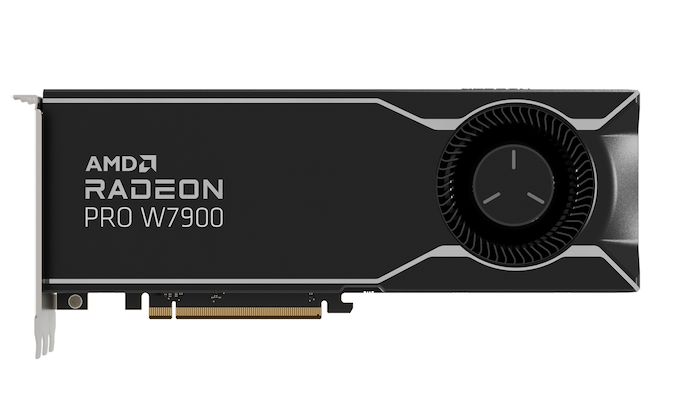
With their initial consumer desktop and mobile RDNA 3 graphics products now out the door, AMD today is turning their attention to the professional visualization market. The more lucrative end of the GPUs-for-graphics business, the professional visualization (proviz) market is a small but important segment of the larger video card market, with workstation users asking for more RAM, more I/O, and more support than a consumer graphics card can provide. Served by AMD’s long-running lineup of Radeon Pro video cards, today AMD is announcing the next generation of high-end workstation cards, the Radeon Pro W7900 and Radeon Pro W7800.
The first workstation-class cards based on AMD’s new RDNA 3 GPU architecture and associated Navi 31 GPU, the new Radeon Pro cards kick off the overall Radeon Pro W7000 family. The W7900 and W7800 are roughly analogous to AMD’s consumer Radeon RX 7900 XTX and 7900 XT cards, offering two tiers of high-end performance at different prices, and aimed at slightly different markets. Though both cards come with identical feature sets, including ECC memory support and, for the first time in any video card, full DisplayPort 2.1 UHBR20 support – the highest bandwidth mode that the DisplayPort specification provides.
These cards, in turn, are aimed at the traditional workstation market. Which is to say CAD, CAM, 3D animation/rendering, video editing, visual effects, and increasingly, the AI acceleration of all of the above. Many of these are tasks that require vast amounts of VRAM, and many of them are also primarily rasterization-bound, which has played well to AMD’s architectural designs in the last couple of generations.
None the less, the launch of these cards comes as, not unlike AMD’s consumer graphics division, AMD’s workstation graphics division is largely on the outside looking in. NVIDIA has held the lion’s share of the proviz market for the last several years, and each generation finds AMD looking at clawing some of it back. The results of those efforts are mixed – NVIDIA still holds the bulk of the market – leaving AMD to try to capitalize on pricing and any feature blind spots in NVIDIA’s product lineup. This latest generation is no exception, as AMD’s biggest selling point remains their performance-per-dollar advantage over NVIDIA.
None the less, there are some bigger changes going on in this generation of Radeon Pro cards than even AMD’s own press materials will be highlighting. This is the first time in years that AMD has offered more than a single high-end workstation card, as AMD is breaking away from some of their self-imposed design restrictions for workstation cards. Consequently, the physical size of AMD’s flagship W7900 has increased significantly – and so has its price, for that matter. Finally, workstation users long-accustomed to high-end AMD cards sporting 6 DisplayPort outputs will have to get used to just 4, though now with more bandwidth than ever before.
Coupled with the major architectural changes brought on my AMD’s RDNA 3 GPU architecture, it’s clearly a time of transition for AMD’s workstation video card lineup. Though, as always, the goals remain the same: improving their product stack and taking a bigger piece of the proviz pie for themselves.
| AMD Radeon RX 7000 Series Specification Comparison | ||||||
| AMD Radeon Pro W7900 | AMD Radeon Pro W7800 | AMD Radeon Pro W6800 | AMD Radeon Pro VII | |||
| ALUs | 12288 (96 CUs) |
8960 (70 CUs) |
3840 (60 CUs) |
3840 (60 CUs) |
||
| ROPs | 192 | 128 | 96 | 64 | ||
| Boost Clock | 2.5GHz | 2.5GHz | 2.32HHz | 1.7GHz | ||
| Peak Throughput (FP32) | 61 TFLOPS | 45 TFLOPS | 17.8 TFLOPS | 13.1 TFLOPS | ||
| Memory Clock | 18 Gbps GDDR6 | 18 Gbps GDDR6 | 16 Gbps GDDR6 | 2.0Gbps HBM2 | ||
| Memory Bus Width | 384-bit | 256-bit | 256-bit | 4096-bit | ||
| VRAM | 48GB | 32GB | 32GB | 16GB | ||
| ECC | Yes (DRAM) |
Yes (DRAM) |
Yes (DRAM) |
Yes (DRAM) |
||
| Infinity Cache | 96MB | 64MB | 128MB | N/A | ||
| Total Board Power | 295W | 260W | 250W | 250W | ||
| Manufacturing Process | GCD: TSMC 5nm MCD: TSMC 6nm |
GCD: TSMC 5nm MCD: TSMC 6nm |
TSMC 7nm | TSMC 7nm | ||
| Architecture | RDNA3 | RDNA3 | RDNA2 | Vega (GCN 5) |
||
| GPU | Navi 31 | Navi 31 | Navi 21 | Vega 20 | ||
| Launch Date | Q2'2023 | Q2'2023 | 06/2021 | 06/2020 | ||
| Launch Price (MSRP) | $3999 | $2499 | $2249 | $1899 | ||
Radeon Pro W7900
Diving on down, let’s take a look at the cards themselves. The flagship of the new generation of workstation cards is the Radeon Pro W7900, and it is a whopper. The fully-enabled (96 CU) Navi 31-based card doesn’t hold back in features or performance. AMD has given the card the same GPU configuration and the same clockspeeds as the consumer Radeon RX 7900 XTX, but has paired it with an even larger 48GB of GDDR6 memory. The net result is a card that is rated for the same peak single precision (FP32) throughput of 61 TFLOPS, but with twice as much memory at its disposal – a huge selling point for the workstation market.
The trade-off for that memory, however, is that AMD has backed off on memory clockspeeds a bit compared to their consumer graphics card. Here the W7900 is running its GDDR6 memory at 18Gbps, for a total of 864 GB/second of memory bandwidth. Like the past few generations of Radeon Pro cards, AMD supports soft ECC for their VRAM, allowing the card to catch and correct VRAM memory errors and boosting the reliability of the resulting product.
Meanwhile, as a trade-off for packing in a fully-enabled Navi 31 chiplet GPU into a workstation card, AMD has also needed to grow the TDP of the card as well. At 295 Watts, the W7900 still runs 60W cooler than its consumer counterpart, but that’s also 45 Watts higher than its predecessor, the Radeon Pro W6800.
As a result, AMD has bulked up the physical card in order to still quietly cool the more power-hungry product, turning the W7900 into a triple slot card. This is a notable departure from AMD’s previous workstation cards, which have been (at most) dual slot cards. Even NVIDIA’s own RTX lineup has held the line at dual slots (albeit at a 300W TDP), presumably for compatibility and familiarity reasons.
Triple slot cards (and larger) are, at this point, old hat to the gaming community, but it’s a notable change for a product designed for the much more conservative workstation market. To be sure, the card itself is still within PCIe specifications – it’s only wider, not taller – so there shouldn’t be any significant compatibility issues, but it means workstation vendors will need to reserve a little more space for AMD’s flagship card. If nothing else, this is a sign of the times for GPU design: even workstations cannot avoid GPU power creep forever.
In any case, AMD is targeting a 1.5x performance gain for the W7900 versus its closest predecessor, the W6800. This tracks closely to what we’ve seen from Navi 31 so far on AMD’s consumer cards, though as always, the specific gains will be workload dependent. Outside of raw performance, the other big selling point for the W7900 over the W6800 will be memory capacity, which is coincidentally also 1.5x what the 32GB W6800 offered.
It’s also worth noting that AMD is wisely opting not to claim that the W7900 is going to be able to match the performance of NVIDIA’s flagship RTX 6000 Ada. NVIDIA throws more silicon and more transistors at the matter than AMD does, and it shows in regards to performance. AMD says that they still get rather close in terms of SPECviewperf performance (missing the RTX 6000 Ada by 7%), but AMD is explicitly going for the value spoiler instead of the workstation performance crown.
Radeon Pro W7800
For workstation users who do need a more traditional card, AMD is also offering the Radeon Pro W7800. A second-tier high-end workstation card, the W7800 is the more conventional counterpart to the W7900, offering lower performance at a lower price, and all in a dual slot card design.
The W7800 isn’t quite as analogous to the consumer RX 7900 XT as the W7900 was, but it’s close. Here we’re looking at a cut-down Navi 31 with 70 CUs enabled, with similarly high clockspeeds as its bigger brother. The peak throughput for the card is rated at 45 TFLOPS, so in compute/graphics workloads, it should offer around 74% of the performance of AMD’s flagship video card.
Along with cutting down the GPU, the memory subsystem is also cut down here. AMD has equipped the W7800 with a 256-bit memory bus – specifically, using just 4 working Memory Control Die chiplets – which is clocked at the same 18Gbps rate as the W7900. As a result, the W7800 is equipped with 32GB of VRAM offering 576GB/second of memory bandwidth, with soft ECC support on top of that. The reduction in MCDs also means the total amount of infinity cache available to the card has been reduced, going from 96MB on the W7900 to 64MB on the W7800. This will have a knock-on effect on performance, though the GPU and memory subsytems remain relatively balanced overall.
And as noted previously, this is a more traditional dual slot card design. The cut-down card has a TBP of just 260 Watts, making it a drop-in replacement for AMD’s previous Pro card.
RDNA 3 For Workstations: Chiplets, AV1, & True DisplayPort 2.1
The announcement of the Radeon Pro W7000 also marks the introduction of AMD’s new RDNA 3 GPU architecture into the workstation ecosystem. And while we normally don’t get any surprises with workstation cards – given that they arrive months later than consumer cards – AMD has saved a little something extra for the Radeon Pro family with regards to display connectivity.
First off, as noted previously, both of these new cards are using AMD’s chiplet-based Navi 31 GPU in differing configurations. As with the launch of their consumer parts last year, AMD is promoting the design efficiencies that the chiplet-based approach entails. That said, while a chiplet-based discrete GPU is every bit as technically impressive now as it was back in November of 2022, it’s not a feature per-se. Rather it’s primarily a cost optimization technique for AMD, which in the case of workstation products, helps AMD to deliver on better performance per dollar than NVIDIA.
From an architectural standpoint, of particular interest for workstation customers will be AMD’s AI accelerator blocks. Though far from what NVIDIA has done with their tensor cores, the AI blocks none the less represent a significant boost in dense matrix math throughput for AMD’s hardware. Otherwise, for more traditional rendering workloads that are primarily shader (compute) bound, RDNA 3 also brings with it its dual issue stream processors, which double the number of ALUs available for vector computing needs. Though as we’ve seen in AMD’s consumer cards, the situational availability of the second ALU means that the actual performance gains even in shader-bound workloads will generally not be quite as high as the theoretical throughput of the hardware.
The latest generation of hardware also means that Radeon Pro users are getting AV1 video encoding for the first time, via AMD’s dual media engine. The W7000 series cards will be able to encode and decode AV1 at up to 8Kp60, and as the “dual media engine” name implies, when it comes to H.265/H.264, it can encode two streams at once.
Finally, in a surprise development for AMD’s Pro cards, AMD has saved the best for last for their display engines and resulting DisplayPort capabilities. The Radeon Pro W7900 and W7800 don’t just have DisplayPort 2.1 compatibility, but they ship with support for the standard’s highest data rate: UHBR 20. UHBR20 provides 20Gbps of raw bandwidth per DisplayPort lane, for a total of 80Gbps of raw bandwidth – or 77.37Gbps after overhead is removed. This is a notable (and unexpected) improvement over AMD’s consumer cards, which although also shipping with DisplayPort 2.1 compatibility, only supported the UHBR 13.5 data rate, for a total of 52.2Gbps of display bandwidth. So the Radeon Pro cards offer upwards of 50% more DisplayPort bandwidth than AMD’s consumer Radeon cards.
In any case, the inclusion of UHBR 20 support is important for a few reasons. Besides making AMD the first vendor to ship a card that can reach these data rates – a notable feat on its own – UHBR 20 speeds are required to drive an 8K display without any compromises. That is, a full 7680 x 4320 pixels refreshing at 60Hz with 10bpc color and full (4:4:4) chroma subsampling, requiring a total of 62Gbps of data altogether. For links that operate any slower – even DP 2.1 UHBR 13.5 – some kind of compromise would be needed, be it chroma subsampling or lossy display stream compression. Few consumers are going to have an HDR-capable 8K monitor any time soon, but for the workstation market, this is an important distinction.
It’s also a significant technical advantage that they’re more than happy to promote. With NVIDIA being limited to DisplayPort 1.4 (HBR3/25.92Gbps), AMD has a significant bandwidth advantage with their latest generation of proviz cards. Besides enabling non-compromises 8K video, it also means they have enough bandwidth to push up to 12K video at 60Hz when using DSC as well.
But with all of that said, this generation of Pro cards are a give-and-take tradeoff for AMD. While the W7000 series card offer much more bandwidth per DisplayPort, they offer fewer DisplayPorts overall. AMD has given up their Eyefinity 6-style layout of 6 mini-DisplayPorts on a single card, in favor of a more traditional 4 port configuration. Specifically, both W7000 series cards offer 3 full-size DisplayPort 2.1 ports, and a single mini-DisplayPort 2.1 port. As a result, the cards can only directly drive 4 displays, as opposed to 6 displays on AMD’s earlier Pro cards. This is no worse than NVIDIA – who also only offers 4 display outputs – but it means AMD no longer has an advantage in total displays, either.
Retail Cards Shipping in Q2’2023, OEM Systems in H2’2023
Wrapping things up, as is often the case for workstation hardware, today’s announcement is just that: an announcement. Although AMD is revealing the cards today, they aren’t launching them quite yet.
According to the company, the Radeon Pro W7900 and W7800 will be available at retailers starting at some point this quarter (Q2) (Update: 5/26). The W7900 will carry an MSRP of $3999, while the W7800 will sell for $2499. Meanwhile the cards will start shipping in prebuilt OEM systems a bit later, with the first W7000-equipped systems expected in the second half of the year.


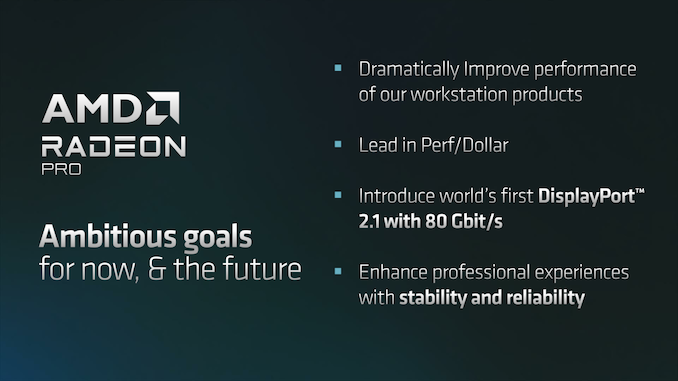
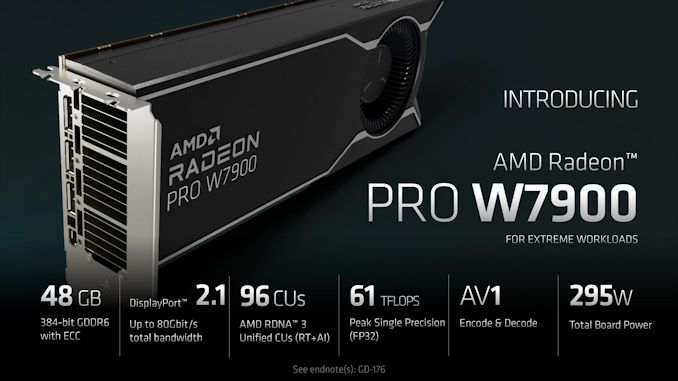

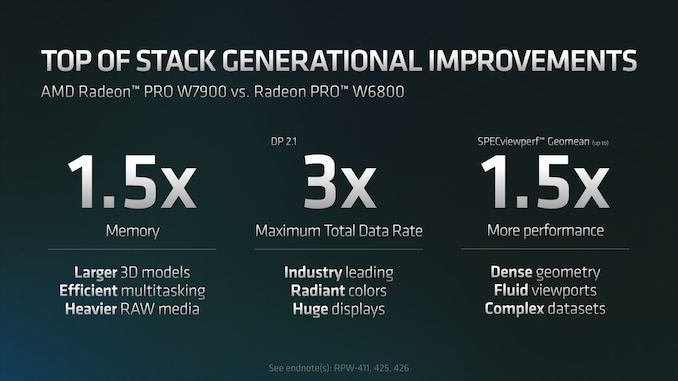
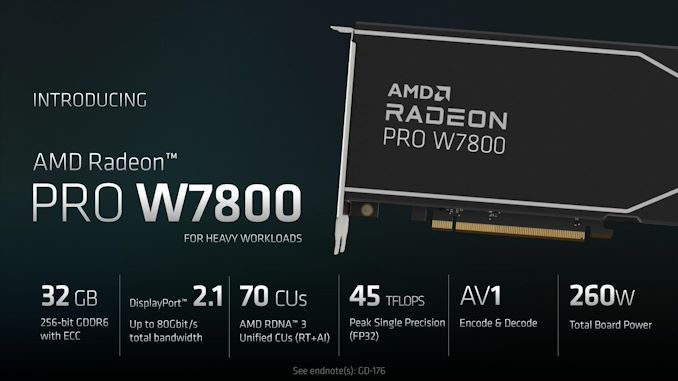

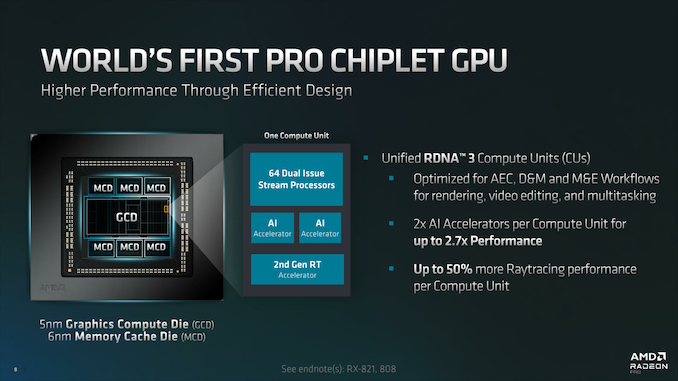


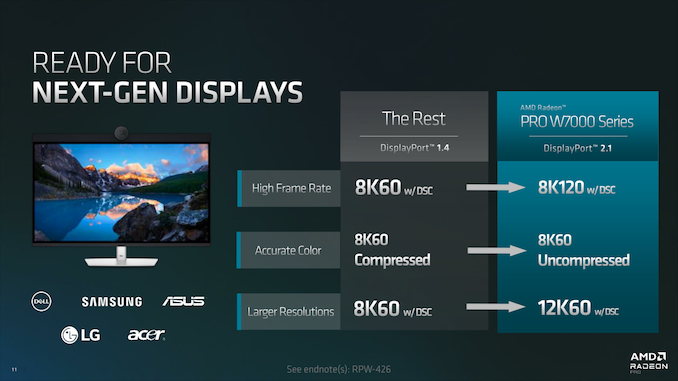
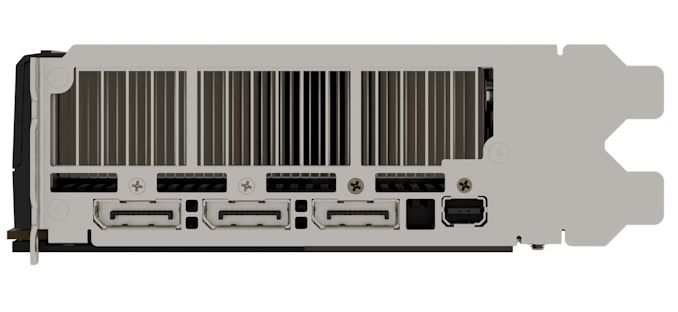
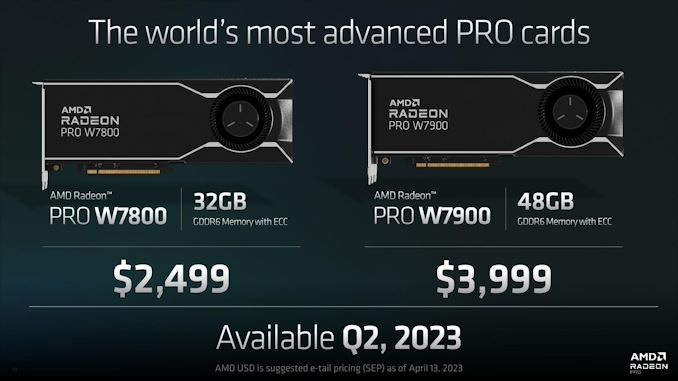














31 Comments
View All Comments
krazyfrog - Thursday, April 13, 2023 - link
Did you completely skip the 4070 announcement?mikegrok - Thursday, April 13, 2023 - link
Their partner site tomshardware.com handled the 4070 announcement.TheinsanegamerN - Thursday, April 13, 2023 - link
So I guess anandtech finally dropped the mask on the whole "were totally gonna review GPUs again guys" thing?Ryan Smith - Thursday, April 13, 2023 - link
I still very much would like to be reviewing video cards, and some day I hope to get there. But the amount of lab work required to put together a good, comprehensive video card review in absolutely enormous. For the moment, it's proven extremely challenging with the limited resources available.StevoLincolnite - Thursday, April 13, 2023 - link
I have been coming to this site for decades... I absolutely loved the deep dives that got into the nitty and gritty on how various pieces of silicon worked and more over the decades.Case in point, the amazing SSD Anthology article that was written in 2009, extremely well researched, but it also educated your readers on a then-emerging technology.
I get it, that the site lacks resources, it's been a big issue over the last several years.
But as I spend more time venturing elsewhere to get my information, I spend less time on Anandtech, which means less clicks, less revenue and eventually less resources available for the site as a whole.
Something needs to change, it's not the number 1 port of call for many of us long-time readers now.
Ryan Smith - Friday, April 14, 2023 - link
I hear you, and it's definitely something I'm painfully aware of. We're not giving you guys enough content to check in on a daily basis.Eliadbu - Friday, April 14, 2023 - link
This is sad, I know several of the writers\editors left, and you can't just cover all of the content and keep the gold standard you have set. I hope one day maybe you bounce back from the position you're in.kn00tcn - Friday, April 14, 2023 - link
why is everyone so focused on full lab graphics reviews, we have a selection of those elsewhere that have the equipment for measuring things like granular power delivery and 1% lows seem to have become pretty standard (but i still think we need framerate line graphs over time, not average bars)what's more valuable from anand are the technical deep dives, architecture explanations, and industry interviews, i'm especially fond of the exclusive behind the scenes ati terrascale backstories well past launch
it also seems odd that toms content is not mirrored or collaborated (what if toms does the testing and anand does the architecture+explanations)
Threska - Saturday, April 15, 2023 - link
Leveraging off others big investments although I'm sure LTT wants to keep all his clicks in a world that doesn't value them enough.TheinsanegamerN - Tuesday, April 18, 2023 - link
Because GPU reviews bring in clicks. The technical deep dives are expensive and time consuming. You need something else to pad out the site.Anyone who used to frequent Anandtech 10 years ago will tell you this place is a dead zombie shambling compared to what it used to be.